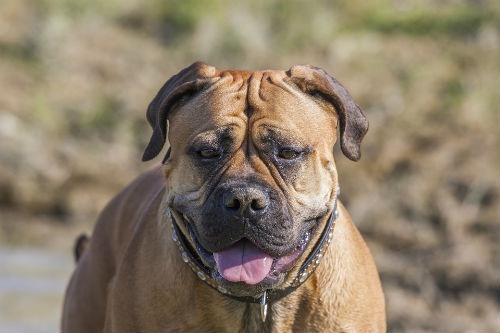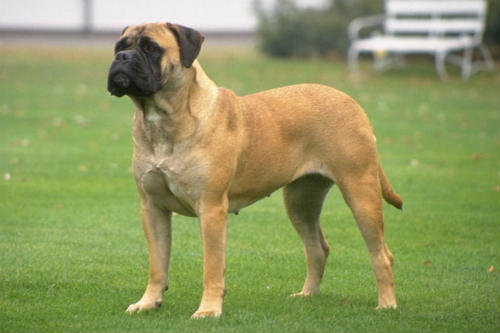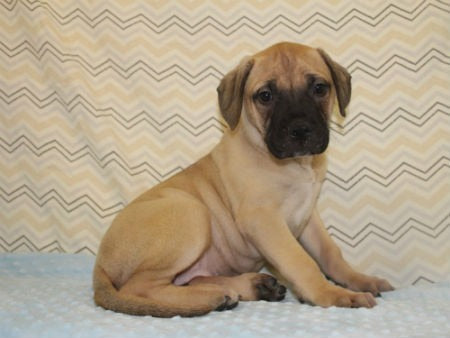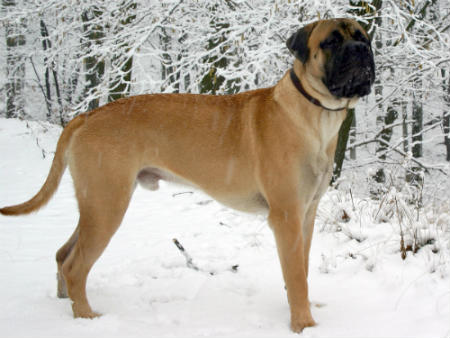It's not a Bulldog or a Mastiff...it's a Bullmastiff !!! one of the most balanced dogs that exist according to the opinion of experts and qualified trainers in the world. Since previous centuries , this breed of dog was preferred by forest rangers and landowners to confront and neutralize illegal hunters and those who lurked in the regions where it lived without becoming violent. A firm, obedient, protective and affectionate dog at the same time. If you decide to adopt or buy one, here we will tell you everything you need to know: from its breeding to the price at which it is valued in the current market. Keep reading and you will know how to best care for your Bullmastiff .
- Size : Giant.
- Weight: Between 45 and 55kg.
- Hair type : Short, straight and hard.
- Character : Intelligent, calm, sociable and affectionate.
- Health : Healthy
- Life expectancy : Between 8 and 12 years.

History of the Bullmastiff
The Bullmastiff is a breed that became known as such in the 19th century , but its origins come from the 13th century.
It is native to Europe, specifically Great Britain, and from there it spread to the Iberian Peninsula and other regions of the continent. Their crossing arose from the need of English gamekeepers to have a dog that could pursue poachers who stalked the forested regions and who illegally entered the private lands of large landowners, usurping the existing fauna . An illegal activity that had become a big problem and that due to the cunning of these poachers was not ending. So it was thought to look for a canine guardian that was big and strong like the Mastiff and at the same time agile and cunning like the Bulldog , without being aggressive, but that was also very obedient. From this crossing the Bullmastiff was born, and the results were surprising, since its keen sense of smell to track its prey over several days, together with its great resistance and strength, made the Bullmastiff the ideal dog for this work of surveillance and protection .

Initially the name this breed received was “ Gamekeeper's night dog ”, which in Spanish translates to “ Gamekeeper's night dog ”.
It is worth mentioning that, although it is a breed native to the United Kingdom as described in the records, its existence was already known in Spain under the name " Bulldogs ", and proof of this is the oil paintings of the Spanish painter Goya, dating from 1800, and by Manuel Castellano, from near later dates, where you can see these specimens with the appearance very similar to what they have today.
Another breed of dog that is also English is the Bobtail dog , and you can read about it on our blog.
Physical characteristics of the Bullmastiff
The Bullmastiff is a large dog but not giant. It is within the category of dogs known as molossoids due to its large muscular and robust build. According to the FCI classification it is classified in Group II . Due to their characteristics, they fulfill the functions of guard dogs very well, but at the same time, if they are raised correctly from puppies, they become very affectionate with their masters and with the rest of the family members .

Height
In males the average height is between 60 and 70 cm and females are a little shorter, usually between 60 and 65 cm. It reaches its maximum height around 3 and a half years.
Weight
Males are thicker and heavier than females, as in other similar dog breeds. Males weigh between 50 and 60 kilos and females weigh between 45 and 55 kilos.
Head and snout
Wide, robust and square in shape with folds. The snout is short, wide and square in appearance. The truffle is round and has open windows.
eyes and ears
His eyes are medium-sized and dark, squinted. Deep looking. Their ears are small, drooping and triangular; Darker in color than the rest of the fur as well as its snout.
Body
He has a vigorous body. With a short and very straight back that towards the back and chest becomes more robust, wide and muscular. Deep chested.
Line
Long, high and strong insertion.
Mouth
The Bullmastiff is a breed of dog that drools a lot. There are no records of the type of bite of these dogs since it is not a dog trained or used to bite but to knock down and immobilize its adversary. Its lower jaw is wide. With large canines and strong teeth.
Fur
Short, smooth and hard. Light brown (beige), red or brindle in color. It usually has a white tuft on its chest. This type of coat is ideal for withstanding extreme weather conditions. Black marks on the face are always present regardless of coat color.
Life expectancy
Between 8 and 12 years old, but everything will depend on the care and nutrition we provide.
Despite being a dog that may appear fearful at first sight, it is very calm, reserved and always on alert. He is very docile and protective of his masters and is always calm. He inherits from the Bulldog that friendly and protective treatment towards children, so if you leave him alone with them they will not run any risk.
Despite being a large dog, he likes and feels comfortable living inside the house, to which he adapts without causing any damage. The only thing you should know is that he needs routine walks to make him feel happy and to keep him in good shape.
Personality
 The Bullmastiff is a very brave dog and nothing upsets him or scares him, on the contrary, he inspires a lot of confidence. In front of strangers they are very calm and not aggressive at all . They are not dogs that bark much either, there must be a very big reason for the Bullmastiff to start barking, and his bark is loud and even his hair stands up in the face of imminent danger, but the rest of the time he is silent. And if, by chance, an intruder invades its territory, like a good hound it will detect its presence and will not bark to scare it away, rather it will seek to knock it down and neutralize it without attacking or biting it until waiting for an order from its master. If you have a Bullmastiff you will know that what we tell you is true.
The Bullmastiff is a very brave dog and nothing upsets him or scares him, on the contrary, he inspires a lot of confidence. In front of strangers they are very calm and not aggressive at all . They are not dogs that bark much either, there must be a very big reason for the Bullmastiff to start barking, and his bark is loud and even his hair stands up in the face of imminent danger, but the rest of the time he is silent. And if, by chance, an intruder invades its territory, like a good hound it will detect its presence and will not bark to scare it away, rather it will seek to knock it down and neutralize it without attacking or biting it until waiting for an order from its master. If you have a Bullmastiff you will know that what we tell you is true.

A small weakness that the Bullmastiff presents is that they are not very friendly with other dogs, over whom they seek to impose themselves and dominate, so at the time of their training their socialization process with other dog breeds is important so that they maintain the same balance as presents to people.
Bullmastiff Feeding
A large dog like the Bullmastiff needs good quality dry food to help it perform the functions of guard and protector dog very well.
Feed it twice a day . Use foods from brands that contain an adequate balance of proteins with an adequate supply of vitamins, minerals and enzymes. We tell you this because an excess of protein would be counterproductive, especially when it is in its growth stage, since it can cause problems in its joints. Prevents you from becoming overweight at any age.
Daily portions vary depending on your Bullmastiff's life stage. Up to 5 months of age, portions should not exceed 400 grams per day. Up to 8 months, provide portions of up to 500 grams daily. At one year the portions should not exceed 550 grams and from 12 months onwards you should reduce the portions to 400 grams again. We do this to find the right weight and not have an obese pet, but rather a healthy, agile and happy dog.

You can add raw foods in small proportions such as beef. They also serve tongue, beef heart, and combine it with salt-free foods such as spinach, celery, broccoli, carrots and cauliflower, which will provide those vitamins that dry animal foods often lose in their preparation process. When you supply them, you defrost them and supply them at room temperature in small pieces. Natural foods should be supplied little by little and with the knowledge of your veterinarian. Also, do not combine the two types of food at the same time.
Don't forget that dry foods cause more water intake than natural foods, so if you choose to give natural foods you will see that the amount of urine decreases. The water should be changed daily and the containers cleaned to avoid the presence of germs and grease from food waste. Avoid eating too quickly during feedings, as this can lead to episodes of hiccups caused by swallowing air.
Health
To complete its optimal state of health, you should brush it two to three times a week and bathe it every 15 days with a neutral shampoo. Combine its care with 2 or 3 moderate walks daily.
In general, the Bullmastiff does not usually have hereditary diseases. However, it is advisable that you have it protected against diseases that affect dogs such as canine respiratory complex or cutaneous leishmaniasis .
The first thing you should know is that you should not acquire a Bullmastiff less than two months old, since its lactation process is very important and if it is weaned before completing this process it does not have those nutrients that breast milk provides.

puppies
These little dogs are very naughty and can be clumsy with children due to their status as puppies, so don't think that the dog appears to be a threat to the smallest members of the family, but it is an indication that they need training from the beginning. 6 weeks.
As we do not want an obese puppy, since the fact that it is “chubby” is not a sign of good health, you should feed it with a dry feed with an adequate balance of proteins, cereals, vitamins and calcium, ideal for large breeds in the stage of growth. Don't forget to be strict about vaccination control and keep in touch with your veterinarian more than twice a year.
If you adopted a Bullmastiff as a pet ... Congratulations!!! You have made a great choice. If, on the other hand, you are interested in buying a specimen of this breed, the price varies depending on the breeder, age, sex, training and nutrition it receives.

Buying a Bullmastiff
At the time of purchasing it you must know who its parents are, as well as their health status and the kennel of origin. The price of a Bullmastiff with a pedigree and all its regulations up to date varies, but the cheapest is around 300 euros. From then on the price can reach up to 1300 euros. A female specimen for breeding is available at an average price of 500 euros. There are those who offer a litter of 3 copies online at a price of around 750 euros. As you will see, this breed of dog, if you are really interested, needs a large investment, but we assure you that you will not regret having done so. Another reference that may be of help to you is the age at which you acquired this copy. A Bullmastiff approximately 50 days old (with its pedigree and vaccination card in order) can be purchased at a price of 800 euros. Also the price of a puppy already dewormed, vaccinated and with a health guarantee, you can get it for a price of 900 euros. A 5-year-old specimen is sold at a price of 500 euros.

Conclusion
In conclusion, the Bullmastiff is an exceptional dog, especially for living with a family . Although it is a dog classified as a guard, the truth goes further, and is that it is an excellent companion. His loyalty to his owner and the rest of the family members makes him an adorable pet . If you are available to have a partner and have them give birth to a litter of these specimens, you will not imagine the moments of happiness you will have. Despite its robust and firm appearance, it has a very sweet character, and especially for the little ones in the house, with whom they will not waste hours of entertainment and care for them. Dare to acquire a specimen of this breed and share with us your moments of happiness and experiences.
Other giant dog breeds:












